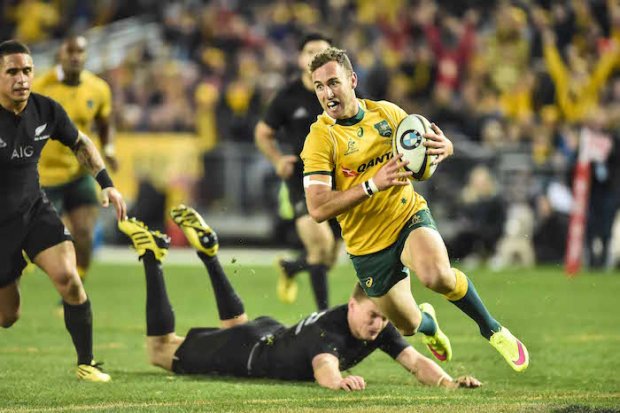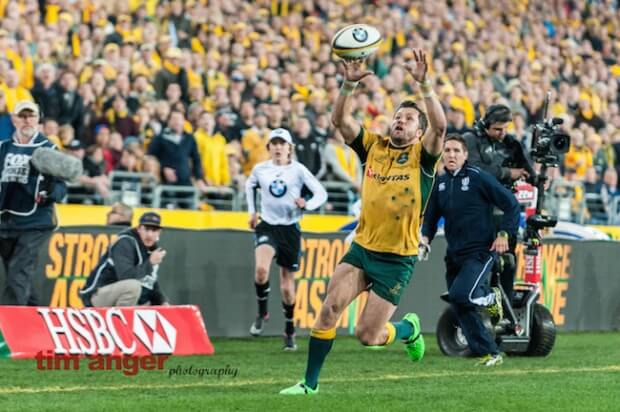On Thursday night, AEST, I was chatting to a mate of mine in Sydney. I commented that I wouldn’t be surprised if Michael Cheika pulled out something a bit left field with the Wallabies RWC squad selection. Quite.
The Selections
All the headlines will focus on the personnel. It’s hard to really mount an effective case for why Kane Douglas was included in place of stalwart and ex-captain James Horwill.
It seemed to me (and I’m not a Queenslander) that Horwill was probably playing better during the Rugby Championship than he had for a long time, possibly since 2013. He was physical, he was getting around the park, he was carting the ball up effectively, he was cleaning out rucks. Not all of the other locks were doing all of those things well and consistently. And he was part of the best scrum performance by a Wallaby side in probably ten years, against the All Blacks in Sydney.
Those who cite his missed tackle on Dan Carter in Auckland, which led to Dane Coles’ try, are being manifestly unfair. Horwill did well to get into that position from the maul across the field. It was Michael Hooper shooting out of the line – and failing to close down the attack – which left Horwill all alone in huge amounts of space. In sum: not Horwill’s fault. It is much more likely that the dysfunctional lineout in both games counted against him (not that Douglas is renowned for his prowess there, I would stress).
All coaches have favourites. Cheika long stood by Douglas in the second row, just like Ewen McKenzie saw a lot of what he liked at lock in Sam Carter. It happens. However, new coaches, like politicians, only have so much capital with the players and the public. I can’t speak to the former, but this decision has cost Cheika a fair bit with the latter.
Elsewhere, the big call was the omission of Nic White. It now seems obvious that White was actually deemed surplus to requirements a while back, but forced himself back into contention in Sydney – with Nick Phipps’ awful game not hurting either. True, White didn’t play well in Auckland. But neither did 90% of the team.
The plan is now for Matt Giteau to cover at 9. Emphasis on “cover”. It really shouldn’t be forgotten that apart from a bit of time there prior to the 2007 World Cup and a handful of minutes this winter, Matt actually doesn’t have much experience in the 9 shirt at all, especially at test level.
The other big winners were Toby Smith, who has yet to make his test debut, and Sean McMahon, who hasn’t featured at all in 2015 after a handful of Cheik-caps on the 2014 Spring Tour. Smith could easily have lost out to Tetera Faulkner, while with Dean Mumm going, there wasn’t a compelling reason to include McMahon either. He’s an undeniable talent, though, with much of the mongrel and work rate that Cheika loves. Good to see him get the rub of the green here.
The Balance
Which brings us to squad balance. If Nic White’s omission opened up space for another player, then so too did the truly major shock of the day: the decision to take only two hookers.
We should spell out just why this is so risky. Teams have to carry designated reserves in each front row position in every matchday 23. If either Stephen Moore or Tatafu Polota-Nau so much as gets concussed in an early game and has to miss the next one, that’s it. Either they head home for good and James Hanson flies in. Or the Wallabies end up faking an injury to another player, who then gets despatched to cover up for Cheika’s initial foolhardiness. None of the other contenders for this Cup – and perhaps no other team full stop – will take two hookers, and few will take only two scrum-halves. This is seriously out there stuff from Cheika.
Let’s point out the obvious: Tatafu Polota-Nau is probably the most injury prone member of this squad (ahead of Cliffy and Quade). Since his debut in 2005, Tatafu has played in *fewer than half* of Australia’s tests. Form has very rarely been the reason.
Some might see the move to take two hookers as a gamble. My response would be that a gamble involves you risking something to gain something else. What is there to gain here? Is anyone seriously suggesting that taking Adam Ashley-Cooper, Rob Horne, Joe Tomane, Drew Mitchell, Henry Speight, *and* Kurtley Beale as a utility isn’t a major case of overkill on the wing spots? Most other teams will carry three specialist wingers and someone else who can play there. What exactly do we gain from omitting Hanson from the party other than an ulcer for all the Wallaby fans and yet more speedsters in suits come game time?
The History
A quick glance at past squads is revealing as to the quality of this one.
The narrowness of the selection pool for 1999 and 2003 really underlines how important the expansion to the Western Force and Melbourne Rebels has been, just as the creation of the Brumbies was pivotal to the 1999 victory. The haters will point out that only one and two players from the Force and the Rebels respectively have made the final cut. But it’s hard to imagine Australian rugby competing at all – for instance, in 2014, when hookers were falling like humans in a zombie movie – without that extra depth. Some really good rugby players missed out on this squad, including guys like James O’Connor, Luke Jones, Lopeti Timani, Nick Cummins, and Nick Frisby, none of whom are even in the train-on squad. Now, the NRC is going to give still more players opportunities to develop into pros; indeed the structure of the comp probably favours precisely those teams because it gives them a year-round rugby platform in Perth and Melbourne. Kudos to everyone from the ARU to the grassroots for making all this happen.
Players inevitably get injured at World Cups. In 2007, Mark Gerrard headed home early for Cameron Shepherd. Then, deeper in the tournament, David Lyons got hurt and Morgan Turinui got sent over as a replacement. In 2011, Drew Mitchell had just come back from being Higginbothamed when he pulled a hamstring, while Cliffy Palu went down in the same game (those crafty Russians). Matt Hodgson and Lachie Turner were their replacements. Bottom line: injuries will happen.
Man for man, this squad matches up pretty well with past cohorts. The front row looks stronger than any we’ve put together since 1999. Other positional groups shape up reasonably well too, though obviously combinations leave a lot to be desired and it’s far from clear what the top team is. Individually, however, there are no passengers in this squad. There was real competition at each position, except for perhaps prop. That hasn’t been the case in the past. For instance, of the ten players in the train-on squad in 2007, nine of them had played fewer than ten tests, and four of them hadn’t played one at all. (Among that cohort were TPN and James Horwill, incidentally.) Plus there was Berrick Barnes, who was actually included in the squad without a cap to his name and then promptly thrown into the hot seat at 10 for the key pool game against Wales, with Stephen Larkham injured. What was I saying again about increased depth and injury-prone players?
Grade
B+. This wasn’t an easy squad to pick. That said, the decision to go with only two scrum-halves and two hookers leaves the squad decidedly vulnerable to the vicissitudes of outrageous fortune. It’s hard to see this as anything other than a really reckless move based on how one might wish a potentially seven-match tournament would pan out, rather than how experience and common sense suggests it will. And to what end?
Who would have thought only one of these guys would make the squad, and it wouldn’t be Kev or Higgers?



